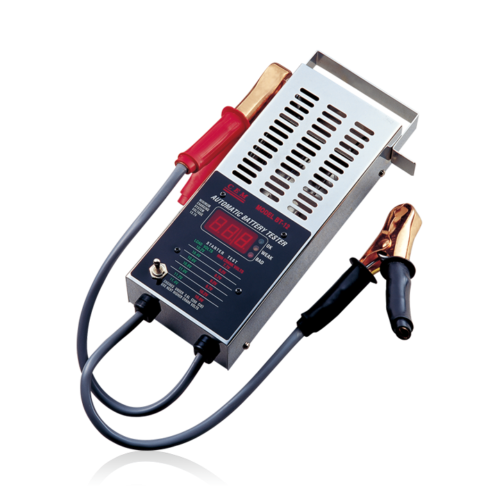CHARGING SYSTEM TEST
This test measures the output voltage of the alternator/ regulator by checking for under or overcharging, which leads to poor battery performance and short life. If you have not already done so, perform battery load test and proceed if the battery is good.
Engine should be at normal operating temperature
1. Connect tester clamps to battery as described in steps 1 and 2 under Battery Load Test.
2. Turn off all lights and accessories. Operate engine at fast idle (approximately 1500 RPM).
3. Do not operate tester's load switch.
4. Read digital voltage displayed on the model.
5. Turn on high beam lights and the blower / heater on high. The voltage displayed on the model should not vary more then a decimal point or two.
If the reading stays relatively the same, the charging system is operating correctly. If the reading drops more than that indicated above, the charging system is not operating correctly.
Trouble shooting hints
Voltage goes low – may be caused by loose belt, defective voltage regulator or defective alternator.
Voltage goes high – may be caused by loose or corroded connections or a defective voltage regulator.
STARTER MOTOR TEST
This test identifies excessive starter current draw, which makes starting the engine more difficult and shortens battery life. If you have not already done so, perform battery load test and make note of the load test voltage. If the load test indicated a weak of bad battery, this test is not available.
Engine should be at normal operating temperature
1. Connect tester clamps to battery as described in steps 1 and 2 under Battery Load Test.
2. Using the table below, find the minimum cranking volts. For example, if load voltage is 11.00, use 9.7 for minimum cranking voltage.
3. Follow the test vehicle's manufacturer guidelines for performing a cranking test. Information on how to do this varies from make, model, and manufacturer. Contact the automobile's manufacturer for specific details.
4. Crank the engine and note the voltage reading during cranking.
5. If cranking voltage if step 3 is below the minimum cranking voltage in "starter test table", the starter current draw is excessive. This may be due to bad connections or a failing starter motor or the battery is too small for the vehicle's requirements.
STARTER TEST TABLE | |||||||
Load Volts | 10.2 | 10.4 | 10.6 | 10.8 | 11.0 | 11.2 | 11.4 |
Min. Cranking Volts | 7.7 | 8.2 | 8.7 | 9.2 | 9.7 | 10.2 | 10.6 |
Note-for an engine of less than 200 CID (Cubic Inch Displacement ) or 3.6L, use the next minimum cranking volts. For example, a load voltage of 11.00 minimum cranking volts would be 10.2 for an engine with 200 CID/3.6L or less.
HELPFUL HINTS
Selecting proper battery size: Use the battery manufacturer's guide for the recommended CA and
Group # for a particular vehicle model. There are two other battery ratings that should be considered depending on the climate where is will be used.
1) CAA (Cold Cranking Amps)-Discharge load measured in amps that a fully charged battery at 0 oF can deliver for 30 seconds while maintaining it's voltage above 7.2 volts DC.
2) RC (Reserve Capacity) – Number of minutes a fully charged battery at 80 ℉can be discharged
at 25 amps until the voltage drops below 10.5 volts DC.
WHY DOES A LEAD-ADID BATTERY GO BAD
Age: Although charging causes the sulfate deposited on the plates to return to the acid, the process is not perfect. A small amount of sulfate insulating residue remains on the plates of the battery (sulfation). With each charge / discharge cycle of the battery this residue accumulates. This process eventually results in diminished electrical conductivity of the plates as well as permanently diluted sulfuric acid and eventually the battery will no longer maintain a charge.
FEATURES
Your model battery analyzer uses the latest electronic and physical devices available. The model is microprocessor controlled for accuracy and rigorously tested for quality. It is the only hand-held digital battery load tester available on the market.
The model battery analyzer uses spark suppression circuitry to reduce the possibility of sparking during connection to the battery.
A piece of broken equipment means a loss of income for a shop as well as the technician. Electronic Specialties has taken this into consideration and has designed the model with over-voltage detection circuitry to help protect internal components and prevent possible break downs.
The model battery analyzer also includes a manual override. If you have started a load test prematurely or you encounter an emergency situation, you can cancel the load test by reactivating the toggle switch at any time during the test.
The model can also be used as a digital voltmeter. You can use your model to check voltage ranging between +8 to +25 volts DC.
The model will advise "CHG" (for charge), if the battery voltage level is below 12.4 volts and battery test is attempted. At this point, the battery should be fully charged before any load test is attempted. Load testing an already low battery can cause further damage to an already suspect battery.
BATTERY LOAD TEST
This test evaluates the battery's ability to crank an engine. The tester draws current from the battery while measuring its voltage level.
The voltage level of a good battery will remain relatively steady under load, but a defective battery will show a rapid loss in voltage.
Battery size (CCA rating) and temperature will affect test results. Follow instructions carefully.
1. Turn off engine and accessories.
2. Connect negative (black) clamp to the negative (NEG, N or-) battery post. Connect positive (red)
clamp to positive (POS, P or +) battery post. "Rock" clamps back and forth to insure a good
electrical connection.
3. With clamps connected, the model will indicate battery's state of charge. If the state of charge is less than 12.4 volts DC and a load test is attempted, the unit will display "CHG" and the battery should then be recharged before load testing. If recharging does not bring voltage to 12.4 volts DC or above, the battery is defective. If the model does not display any reading, check for loose or reversed clamps, otherwise the battery is either defective or the battery voltage is below 8.5 volts DC.
4. Push the load switch (located on the bottom of the model) all the way to the right and release.
5. After 10 seconds the model will indicate battery condition by illuminating one of the three color LEDs (Light Emitting Diode). A one second beep will also confirm the test is completed. Use the table below to help determine battery condition.
6.
Load tester LED | Battery condition |
Green LED light | Battery capacity is OK. Recharge battery to full level. |
Yellow LED light | Battery capacity is not satisfactory. Battery may be either defective or not fully charged. If the battery being tested is not a "maintenance free" type, then check specific gravity to determine which condition exists. If charging does not bring specific gravity to full charge level, then the battery should be replaced. If the battery being tested is a "maintenance free" type, then charge the battery to see if a full charge can be obtained. |
Red LED light | Battery may be defective or very run down and should be replaced. |
Note: The top portion of the tester will heat up due to load current. Allow the tester to cool for at
least one minute between load tests. Do not exceed more then three load tests in a five minutes
period.
CHARGING SYSTEM TEST
This test measures the output voltage of the alternator/ regulator by checking for under or overcharging, which leads to poor battery performance and short life. If you have not already done so, perform battery load test and proceed if the battery is good.
Engine should be at normal operating temperature
1. Connect tester clamps to battery as described in steps 1 and 2 under Battery Load Test.
2. Turn off all lights and accessories. Operate engine at fast idle (approximately 1500 RPM).
3. Do not operate tester's load switch.
4. Read digital voltage displayed on the model.
5. Turn on high beam lights and the blower / heater on high. The voltage displayed on the model should not vary more then a decimal point or two.
If the reading stays relatively the same, the charging system is operating correctly. If the reading drops more than that indicated above, the charging system is not operating correctly.
Trouble shooting hints
Voltage goes low – may be caused by loose belt, defective voltage regulator or defective alternator.
Voltage goes high – may be caused by loose or corroded connections or a defective voltage regulator.
STARTER MOTOR TEST
This test identifies excessive starter current draw, which makes starting the engine more difficult and shortens battery life. If you have not already done so, perform battery load test and make note of the load test voltage. If the load test indicated a weak of bad battery, this test is not available.
Engine should be at normal operating temperature
1. Connect tester clamps to battery as described in steps 1 and 2 under Battery Load Test.
2. Using the table below, find the minimum cranking volts. For example, if load voltage is 11.00, use 9.7 for minimum cranking voltage.
3. Follow the test vehicle's manufacturer guidelines for performing a cranking test. Information on how to do this varies from make, model, and manufacturer. Contact the automobile's manufacturer for specific details.
4. Crank the engine and note the voltage reading during cranking.
5. If cranking voltage if step 3 is below the minimum cranking voltage in "starter test table", the starter current draw is excessive. This may be due to bad connections or a failing starter motor or the battery is too small for the vehicle's requirements.
STARTER TEST TABLE | |||||||
Load Volts | 10.2 | 10.4 | 10.6 | 10.8 | 11.0 | 11.2 | 11.4 |
Min. Cranking Volts | 7.7 | 8.2 | 8.7 | 9.2 | 9.7 | 10.2 | 10.6 |
Note-





